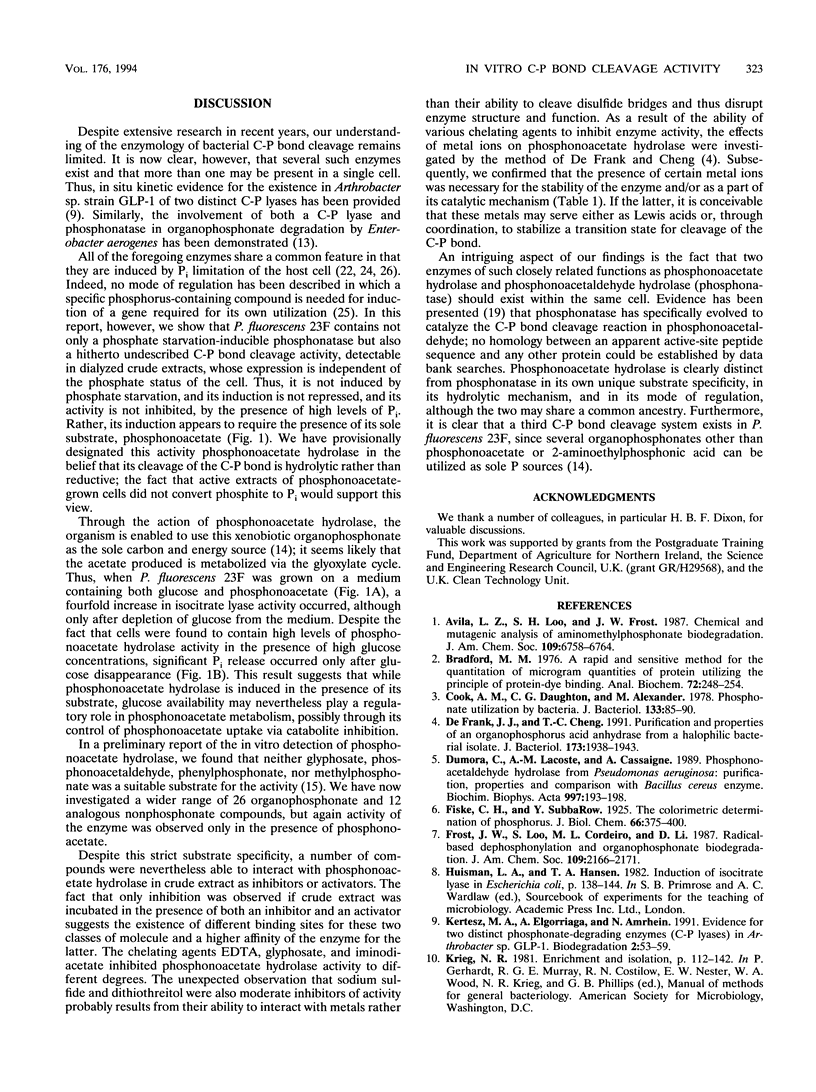Abstract
A novel, metal-dependent, carbon-phosphorus bond cleavage activity, provisionally named phosphonoacetate hydrolase, was detected in crude extracts of Pseudomonas fluorescens 23F, an environmental isolate able to utilize phosphonoacetate as the sole carbon and phosphorus source. The activity showed unique specificity toward this substrate; its organic product, acetate, was apparently metabolized by the glyoxylate cycle enzymes of the host cell. Unlike phosphonatase, which was also detected in crude extracts of P. fluorescens 23F, phosphonoacetate hydrolase was inducible only in the presence of its sole substrate and did not require phosphate starvation.
Full text
PDF




Selected References
These references are in PubMed. This may not be the complete list of references from this article.
- Bradford M. M. A rapid and sensitive method for the quantitation of microgram quantities of protein utilizing the principle of protein-dye binding. Anal Biochem. 1976 May 7;72:248–254. doi: 10.1006/abio.1976.9999. [DOI] [PubMed] [Google Scholar]
- Cook A. M., Daughton C. G., Alexander M. Phosphonate utilization by bacteria. J Bacteriol. 1978 Jan;133(1):85–90. doi: 10.1128/jb.133.1.85-90.1978. [DOI] [PMC free article] [PubMed] [Google Scholar]
- DeFrank J. J., Cheng T. C. Purification and properties of an organophosphorus acid anhydrase from a halophilic bacterial isolate. J Bacteriol. 1991 Mar;173(6):1938–1943. doi: 10.1128/jb.173.6.1938-1943.1991. [DOI] [PMC free article] [PubMed] [Google Scholar]
- Dumora C., Lacoste A. M., Cassaigne A. Phosphonoacetaldehyde hydrolase from Pseudomonas aeruginosa: purification properties and comparison with Bacillus cereus enzyme. Biochim Biophys Acta. 1989 Aug 31;997(3):193–198. doi: 10.1016/0167-4838(89)90186-6. [DOI] [PubMed] [Google Scholar]
- Kertesz M., Elgorriaga A., Amrhein N. Evidence for two distinct phosphonate-degrading enzymes (C-P lyases) in Arthrobacter sp. GLP-1. Biodegradation. 1991;2(1):53–59. doi: 10.1007/BF00122425. [DOI] [PubMed] [Google Scholar]
- La Nauze J. M., Coggins J. R., Dixon H. B. Aldolase-like imine formation in the mechanism of action of phosphonoacetaldehyde hydrolase. Biochem J. 1977 Aug 1;165(2):409–411. doi: 10.1042/bj1650409. [DOI] [PMC free article] [PubMed] [Google Scholar]
- La Nauze J. M., Rosenberg H., Shaw D. C. The enzymic cleavage of the carbon-phosphorus bond: purification and properties of phosphonatase. Biochim Biophys Acta. 1970 Aug 15;212(2):332–350. doi: 10.1016/0005-2744(70)90214-7. [DOI] [PubMed] [Google Scholar]
- Lee K. S., Metcalf W. W., Wanner B. L. Evidence for two phosphonate degradative pathways in Enterobacter aerogenes. J Bacteriol. 1992 Apr;174(8):2501–2510. doi: 10.1128/jb.174.8.2501-2510.1992. [DOI] [PMC free article] [PubMed] [Google Scholar]
- McMullan G., Harrington F., Quinn J. P. Metabolism of phosphonoacetate as the sole carbon and phosphorus source by an environmental bacterial isolate. Appl Environ Microbiol. 1992 Apr;58(4):1364–1366. doi: 10.1128/aem.58.4.1364-1366.1992. [DOI] [PMC free article] [PubMed] [Google Scholar]
- McMullan G., Quinn J. P. Detection of a novel carbon-phosphorus bond cleavage activity in cell-free extracts of an environmental Pseudomonas fluorescens isolate. Biochem Biophys Res Commun. 1992 Apr 30;184(2):1022–1027. doi: 10.1016/0006-291x(92)90693-f. [DOI] [PubMed] [Google Scholar]
- Metcalf W. W., Wanner B. L. Involvement of the Escherichia coli phn (psiD) gene cluster in assimilation of phosphorus in the form of phosphonates, phosphite, Pi esters, and Pi. J Bacteriol. 1991 Jan;173(2):587–600. doi: 10.1128/jb.173.2.587-600.1991. [DOI] [PMC free article] [PubMed] [Google Scholar]
- Metcalf W. W., Wanner B. L. Mutational analysis of an Escherichia coli fourteen-gene operon for phosphonate degradation, using TnphoA' elements. J Bacteriol. 1993 Jun;175(11):3430–3442. doi: 10.1128/jb.175.11.3430-3442.1993. [DOI] [PMC free article] [PubMed] [Google Scholar]
- Olsen D. B., Hepburn T. W., Lee S. L., Martin B. M., Mariano P. S., Dunaway-Mariano D. Investigation of the substrate binding and catalytic groups of the P-C bond cleaving enzyme, phosphonoacetaldehyde hydrolase. Arch Biochem Biophys. 1992 Jul;296(1):144–151. doi: 10.1016/0003-9861(92)90556-c. [DOI] [PubMed] [Google Scholar]
- Olsen D. B., Hepburn T. W., Moos M., Mariano P. S., Dunaway-Mariano D. Investigation of the Bacillus cereus phosphonoacetaldehyde hydrolase. Evidence for a Schiff base mechanism and sequence analysis of an active-site peptide containing the catalytic lysine residue. Biochemistry. 1988 Mar 22;27(6):2229–2234. doi: 10.1021/bi00406a063. [DOI] [PubMed] [Google Scholar]
- Pipke R., Amrhein N., Jacob G. S., Schaefer J., Kishore G. M. Metabolism of glyphosate in an Arthrobacter sp. GLP-1. Eur J Biochem. 1987 Jun 1;165(2):267–273. doi: 10.1111/j.1432-1033.1987.tb11437.x. [DOI] [PubMed] [Google Scholar]
- Rosenberg H., La Nauze J. M. The metabolism of phosphonates by microorganisms. The transport of aminoethylphosphonic acid in Bacillus cereus. Biochim Biophys Acta. 1967 Jun 13;141(1):79–90. doi: 10.1016/0304-4165(67)90247-4. [DOI] [PubMed] [Google Scholar]
- Wackett L. P., Shames S. L., Venditti C. P., Walsh C. T. Bacterial carbon-phosphorus lyase: products, rates, and regulation of phosphonic and phosphinic acid metabolism. J Bacteriol. 1987 Feb;169(2):710–717. doi: 10.1128/jb.169.2.710-717.1987. [DOI] [PMC free article] [PubMed] [Google Scholar]
- Wanner B. L., Metcalf W. W. Molecular genetic studies of a 10.9-kb operon in Escherichia coli for phosphonate uptake and biodegradation. FEMS Microbiol Lett. 1992 Dec 15;100(1-3):133–139. doi: 10.1111/j.1574-6968.1992.tb14031.x. [DOI] [PubMed] [Google Scholar]


